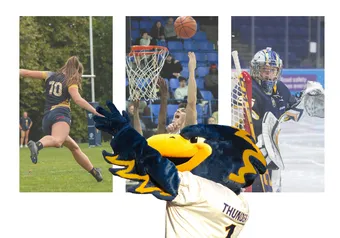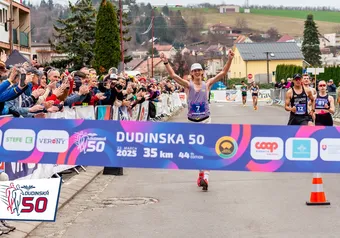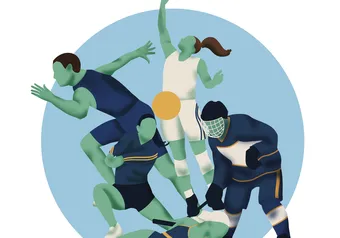UBC Athletics spent $146,144 promoting its 26 Thunderbird teams in 2016, according to a freedom of information request filed by The Ubyssey. Over a third of that money went to football.
The news has upset many varsity athletes who say Athletics has ignored their pleas for basic requirements like coaches and equipment while they spend tens of thousands of dollars on football promotion alone.
The athletics department spent over $52,000 on Homecoming and other football marketing — a necessary expense, said Athletics Senior Director Gilles Lepine, to promote their “best product” and cultivate student, media and donor interest.
“The thing that we can sell right now,” he said, “is to have big events where people feel ... the wow effect. And this wow effect is coming definitely more with football than other sports."
Lepine said Athletics also uses football to help out other teams. For example, Lepine said he first secured a jumbotron-like screen for a football game, then got the sponsor to throw it in for a basketball and a volleyball game as well.
“So that's my way to work — we use one to open the door ... and after that, we can serve other sports,” he said.
But some athletes are feeling left behind by the strategy. T-Bird soccer netminder Chad Bush criticized the heavy investment in the football team while other teams, “many of which are more successful than football, are essentially treated like an afterthought.”
“Why does UBC football 'deserve' over one third of the entire marketing and promotions budget all to themselves?” Bush wrote in an emailed statement.
Former men's field hockey player Matthew Sarmento detailed a litany of struggles his team faced during his time as a T-Bird, including a budget a fifth the size of the amount spent promoting Homecoming, fighting “tooth and nail” to be allowed to access outside funding and debris piling up on the team's home field, which they had to pay to access.
“As an athlete on a lesser-known or a less important sport, it's pretty frustrating to see these numbers, to be honest,” he said, and though he doesn't hold anything against UBC, “it's pretty obvious the school didn't really care too much for our sport.”
“Walking around campus, one cannot help but see all the lawn signs advertising every single home game for UBC football,” wrote Bush. “In my three years living on campus at UBC, never have I seen even a single sign promoting any other sport’s home games.”
The breakdown
The athletics department gets its money from sponsorships, alumni donations and directly from UBC. The money they receive from the university comes in a lump sum — Athletics is free to determine how to spend it, said Director of Performance and Team Services, Gord Hopper.
Included in the January to March ($24,036.82) line item, said Hopper, was newspaper and media ads, merchandise, and profiles by Allsport, a sports insurance marketing agency.
From April to December ($67,550.82) Hopper said the athletics department spent about $30,000 on free Thunderbird t-shirts that were given away to first-years, as well as billboard and newspaper ads, promotional supplies and game activations.
Women's rugby captain Mackenzie Carson said it was “shocking” that Athletics spent nearly $29,000 on Homecoming while her team is “struggling to stay afloat,” having to rely on donations just to keep playing.
Carson said Athletics denied their application for funding for a full-time coach this year, causing further problems for the team.
“The fact that Athletics won't give the bare minimum to some teams, but can somehow afford a ferris wheel at a football game, is laughable,” she wrote in an email to The Ubyssey. The money for the ferris wheel came from the UBC Campus Experience department, not Athletics', said Len Catling, senior manager of communications and media relations for UBC Athletics.
Sarmento, the field hockey player, said UBC wouldn't allow the team to pursue outside sponsorships when his team needed new jerseys and Athletics refused to help the team pay for them.
“It was just a small, four-inch-by-four-inch logo on the arm sleeve, and that was basically kiboshed,” he said. “We fought tooth and nail to get them to turn around or to give us more money — if they could give us $1,000 then we wouldn't need these two other sponsors to come on board.”
After more than a year of persistence, Sarmento said UBC allowed the team to be sponsored by two field hockey shops.
Before UBC, Sarmento played field hockey for four years at the University of Victoria, where the team had three different jerseys, partly due to a lucrative Nike sponsorship for the school's 50th year. UBC had no such luck for its recent 100th anniversary.
Sarmento said the fact that football just got brand new third jerseys was “rubbing salt in the wound, for sure.”
“We have professional players on the team, we have Olympians on the team,” he said of the field hockey team. “And it seemed like, in terms of finances, we were given no support.”
An example of UBC's flippant attitude toward field hockey, Sarmento said, is the fact that the “vast majority” of the team's approximately $6,000 budget went to paying for field time.
“How backwards is that?” he said. “We don't even have preferential treatment to book our own field. That's the UBC field for the UBC field hockey team.”
Sarmento said the field was neglected for long periods of time, causing debris to get in the way of games and practices.
“There was a couple inches of sludge buildup on the side of the field just because it's so dirty, and no one bothers to clean it,” he said. “It's a fast paced game, you need turf that's true and doesn't have leaves and twigs on it.”
After the $52,132.86 total football budget, the last line item is the $2,424.32 spent on the promotion of Thunderstruck, a women's basketball game.
Lepine sighed when asked if he was getting enough support from UBC's administration.
“That''s a big question, coming from another university and seeing how there is,” he said. Lepine previously worked as Director of Excellence for Athletics at Laval University, where football attendance regularly breaks 10,000. Outside of Homecoming, attendance at UBC is rarely over 2,500.
He pointed to the nine championships Thunderbirds won last year as evidence that Athletics is doing its job.
"But that's meant a lot, lot of energy," he said.
The strategy
Lepine said he plans to continue the strategy of promoting a few “carnival-style” games every year, like Winter Classic and Thunderstruck, as opposed to trying to get as many students possible to come to every game.
Since only a few teams are picked for those events, others rely on the student-run Thunderbird Athletes Council (TAC), which works with and receives funding from Athletics to promote athletic pride at UBC.
Bush, the soccer player, and volleyball alumnus Danielle Brisebois said the TAC promised their teams a “hype game,” but that never really panned out.
“I was telling people it was our hype game and they had no idea that it was. Our game was on Friday, and I remember it being Wednesday and there were no posters up at all,” Brisebois said.
Brisebois said she went to the TAC office to get her team's posters printed, then enlisted her teammates to hang them up around campus — but by that point it was the day before the game.
“They didn't even ask us to hang the posters up to promote the game, you know? We thought someone else was going to do it, and no one did,” she said. “It didn't feel any different from another game.”
Bush said the soccer team was also given flyers to hand out the day before their hype game.
“As expected, very few people came out to that game,” he wrote, noting that most attendees were relatives and friends. “It is not uncommon for the 'away' fans to be louder than our own fans.”
Sarmento, who was on the TAC, said the field hockey team had to “piggyback” with the women's team for their hype week.
“Whatever — we'll take it, because that's all we can get, but, like, come on. You can't highlight us for a week?” he said. “You couldn't send a second-year doing his video filming [project] to highlight our practice, or have an interview with our coach, or talk to the five guys on our team that have played for team Canada, or the two guys that have gone to the Olympics?”
Thunderbird swimmer Maia Brundage, who manages the TAC’s finances, said the Council is mainly focused on putting on events for other athletes.
“Ideally, we would want it to be everyone getting a game that's really big and has some hype around it regarding promotion. Right now we just give them the Snapchat and we do some promotion of them ourselves, mostly to get more athletes out to other athletes' games,” she said.
Brundage said that while the TAC doesn't have the resources to throw Winter Classic-level events for every team, Athletics would be wise to try.
“It would be a great investment if other teams could get at least one game where they get to really feel like stars,” she said. “Hyping up one game is not hard.”
While Homecoming and Winter Classic have seen year-over-year attendance increases, hype games haven't turned into sustained interest — after Homecoming 2016's record-breaking turnout of 7,834, the remaining two home games saw fewer than 1,500 fans each.
“I hope we're going to have 5,000 people minimum at every [football] game. But are we there? No,” said Lepine. “For [students] it's a special thing to go to a game. And I hope in a few years it will be natural to go there.”
To make that a reality, Athletics is sticking with largely the same strategy this year. The promotional budget for 2017 has increased to $166,599 — Catling said the increase was mainly due to that jumbotron-esque screen.
“I think we're working very hard to elevate in the community and especially in the students here at the university, the interest with the Thunderbirds,” said Lepine.
“Now, I hope that we can transform that in money. That's what we want to do,” he said. “But first, if the students and the staff here don't believe about the brand, it's tough to sell."
Sarmento hopes that Athletics can improve its relationship with the non-football teams by reaching out to each team, and listening more.
“There are so many athlete stories that could help sell the sport to the school, and not obviously raising money or anything,” he said. “Just throw us a bone.
“From an outsider looking in ... ask yourself, is it a level playing field? Does every athlete have every opportunity to succeed and to be a T-Bird?”
This article has been updated to clarify funding for the women's rugby team and the Homecoming ferris wheel.
Share this article
First online



![['']](https://storage.googleapis.com/ubyssey/media/renditions/brisebois_volleyball_championshi.width-1000.format-webp.webp)
![['']](https://storage.googleapis.com/ubyssey/media/renditions/16-302_-_Response_ltr.width-1000.format-webp.webp)
![['']](https://storage.googleapis.com/ubyssey/media/renditions/hauen_football_banners_nest-1.width-1000.format-webp.webp)
![['']](https://storage.googleapis.com/ubyssey/media/renditions/12622096_10153191965106793_25042.width-1000.format-webp.webp)


